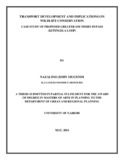| dc.description.abstract | Wildlife dispersal and migratory corridors play a critical role in the conservation of wildlife not only in Kenya but all over the world. Areas dedicated as National Parks may not be sufficient enough to cater for the varying needs of wildlife. When Nairobi National Park was established in 1946, it was immediately recognized that at approximately 117 square kilometers it was too small to meet the ecological requirements of the existing migratory wildlife species (Kristjanson et al., 2002; Gichohi, 2000) and hence the need for the study of the corridor .
Roads on the other hand play an important role in economic development. The city of Nairobi has experienced heavy traffic in its major roads in the recent past. In order to address traffic congestion, the government designed road bypasses to diffuse traffic from the central business district where major traffic routes normally pass. One of the bypasses, the greater southern pose a conservation challenge since it is planned to cut across Kitengela wildlife migration area. This will undermine the conservation efforts of wildlife in Nairobi National Park (NNP) which is a unique park within the city and a major tourist destination.
This study was carried out to; identify and assess wildlife and other environmental concerns in the study area; examine impact of proposed infrastructure development on the environmental and wildlife elements; and propose suitable spatial planning, wildlife and environmental approaches to mitigate against any negative impacts identified for sustainable transport corridor development. A household survey with a sample size of 63 was carried out to examine and assess wildlife and other environmental concerns. Institutional survey was also done to establish the impacts of the proposed infrastructural development on environment and wildlife elements and find out the suitable spatial planning, wildlife and environmental approaches to mitigate against the identified negative impacts for sustainable transport corridor development. Chi-square statistical test was used to test the hypothesis.
The impacts of the proposed road on the environment would include pollution, soil erosion, increased noise, increased human settlement, affect drainage systems, edge effects, reduced water quality and increased invasive species. The impacts of the road on wildlife elements are road mortality, habitat fragmentation, human habituation, habitat loss, increased human use of the area, alteration of the physical environment, modification of the animal behaviour and mortality from construction.
The study recommends: a) KWS to be more empowered to tackle rampant cases of human –wildlife conflicts, more conservation NGOs be encouraged to supplement KWS in conservation and government to develop a policy framework for management of wildlife corridor/ dispersal areas; b) an environmental impacts assessment needs to be carried out to assess the impacts of the many quarrying activities in order to propose and enforce mitigation measures to curb environmental degradation; c) adoption of a landscape-scale planning process that assesses road route alternatives before route selection; d) Involve environmentalist, conservationist and road engineers at all stages of road planning in order to identify all environmental and wildlife impacts, reduce them or avoid them if possible, if not, provide adequate mitigation; e) Integrate conservation planning into transportation planning; f) Build wildlife crossings where necessary to repair ecological damage and restore habitat connectivity; and g) Comprehensive
understanding of the environmental consequences of transportation networks and developing methods to support ecological impact evaluations at early planning stages. | en_US |

